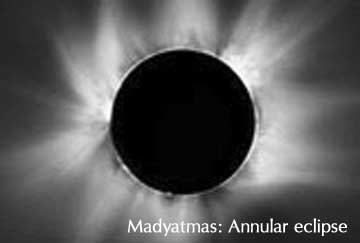This article is in continuation of a series on Das Avatara. Please read (1) Avatāra and (2) Dasa avatāra Overview before this article to get a complete picture.
We have shown the wisdom of our tradition in explaining that there is no real controversy about the list of dasa-avatāra and that each of the lists are meant for a specific purpose like Parāśara list of Iṣṭa devatā, Jayadeva modification for the Bhakti path and Jagannāth list for Dharma devatā. The wisdom does not end there but expands to very subtle and sensitive levels of the individual consciousness which allows for subtle modifications of the lists to meet the individual need.
Hṛṣikeśa replaces Paraśurāma
As an illustration, in the Parāśara list of Iṣṭa devatā or Jagannāth list of dharma devatā we have Bhārgava[i]Paraśurāma who annihilated 21 generations of Kṣatriya and it would be most foolish for any Jyotiṣa to ask a Kṣatriya or Kāyastha to worship Bhārgava Paraśurāma as he would shudder at the mention of the very name, what to talk of developing Bhakti! Instead the worship of Hṛṣikeśa the form in which Lakṣmī worships Viṣṇu is advised as Lakṣmī is naturally indicated by Venus. This is in lines with the teachings of Śrīmad Bhagavataṁ.
Sri Bhakti Vedānta Swami Prabhupada writes “Accompanied during the daytime by the sons of the Prajāpati [the predominating deities of the days] and accompanied at night by his daughters [the deities of the nights], Lakṣmī devī worships the Lord during the period known as the Saṁvatsara in His most merciful form as Kāmadeva (Hṛṣikeśa). Fully absorbed in devotional service, she chants the following mantras. SB 5.18.17
Hṛṣikeśa (Kāmadeva) SB 5.18.18
ॐ ह्रां ह्रीं ह्रूं ॐ नमो भगवते हृषीकेशाय सर्वगुणविशेषैर् विलक्षितात्मने आकूतीनां चित्तीनां चेतसां विशेषाणां चाधिपतये षोडशकलाय च्चन्दोमयायान्नमयायामृतमयाय सर्वमयाय सहसे ओजसे बलाय कान्ताय कामाय नमस् ते उभयत्र भूयात्।
om hrāṁ hrīṁ hrūṁ om namo bhagavate hṛṣīkeśāya sarvaguṇaviśeṣair vilakṣitātmane ākūtīnāṁ cittīnāṁ cetasāṁ viśeṣāṇāṁ cādhipataye ṣoḍaśakalāya ccandomayāyānnamayāyāmṛtamayāya sarvamayāya sahase ojase balāya kāntāya kāmāya namas te ubhayatra bhūyāt|
Hṛṣikeśa (Kāmadeva) Iṣṭa mantra
ॐ नमो भगवते हृषीकेशाय
om namo bhagavate hṛṣīkeśāya
Mahāpuruṣa Yoga
Mahāpuruṣa or greatness in human beings is due to the predominance of one of the five tattva. Lord Śiva alone is a perfect siddha with all the pañca tattva i.e. He alone can manifest with the pañca mahāpuruṣa characteristics. This is taught in the Mahabharata when Draupadi asks a boon to have a husband like Śiva with all the five qualities, Śiva blesses her to have five husbands who are the five Pāṇḍava mahāpuruṣa brothers as no jīvātmā can incarnate with all five tattva in dominance. For more information, please read my paper on Mahāpuruṣa yoga (SJC Annual Conference, Puri).
We know that the nine syllables of the Moon are the semivowels and they form the best sounds for protection of the mana (mind) which is ruled by the Moon. These are given in Table 5. Meditation of the syllables strengthens the particular element or pacifies the mind or purifies the soul. These elemental sounds are repeated thrice as a prefix and suffix to the Gāyatri mantra for maximum benefit.
Kalyāṇavarmā (Sārāvalī) teaches that the Mahāpuruṣa yoga become defunct in the absence of strong luminaries and it becomes necessary to strengthen them by purifying the soul and making the mind resolved with the element akṣara in addition to strengthening the dominant element of the mahāpuruṣa yoga itself.
Table 5: Chandra (Manas) akṣara
| Sanskrit | य | र | ल | व | श | ष | स | ह | क्ष |
| Trans | ya | ra | la | va | śa | ṣa | sa | ha | kṣa |
| Element | vāyu air | agni fire | pṛthvi earth | jala water | manas mind | ākāśa ether | ātma soul | ||
| Graha | Saturn | Mars | Mercury | Venus | Ketu | Rāhu | Moon | Jupiter | Sun |
| Devatā | Śiva | Āditya | Gaṇeśa | Devī | Cāmuṇḍā | Durgā | Gourī | Viṣṇu | Sūrya |
Śiva’s prayer (Mahāpuruṣa dhyāna & mantra SB 5.17.16-18)
भजे भजन्यारणपादपण्कजं
भगस्य कृत्स्नस्य परं परायणम्
भक्तेष्वलं भावितभूतभावनं
भवापहं त्वा भवभावम् ईश्वरम्
bhaje bhajanyāraṇapādapaṇkajaṁ
bhagasya kṛtsnasya paraṁ parāyaṇam
bhakteṣvalaṁ bhāvitabhūtabhāvanaṁ
bhavāpahaṁ tvā bhavabhāvam īśvaram
Mantra
ॐ नमो भगवते महापुरुषाय सर्वगुणसण्ख्यानायानन्तायाव्यक्ताय नम
om namo bhagavate mahāpuruṣāya sarvaguṇasaṇkhyānāyānantāyāvyaktāya nama
Bhagavata (13-syllable) mantra
Note: syllables of the elements and the luminaries can be added to the mantra after the praṇava or suffixed for fruits of saṁsāra.
ॐ नमो भगवते महापुरुषाय
om namo bhagavate mahāpuruṣāya
Jñāna Yoga

There is no substitute for learning other than the holy feet of parama guru Śrī Veda Vyāsa. Jñāna yoga of all kinds must lead to the pure truth force of knowledge and this truth force is symbolized by Vāsudeva, the father of Kṛṣṇa avatāra who was forever truthful and the fruit of his perfect truthfulness resulted in the birth of Śrī Kṛṣṇa as his eighth child. Knowledge and children are seen from the same fifth house which is also the mantra bhāva. All knowledge, both Para and Apara vidyā, should lead to enlightenment as its principal goal. The vasu means light and refers to enlightenment and deva refers to divinity as giving enlightenment. Thus, Vāsudeva means pure enlightenment from learning the truth. In the dhyāna mentioned below, this is specifically indicated as the impeller of the intelligence ‘satyaṁ paraṁ dhīmahi’. Vāsudeva refers to Kṛṣṇa as the son of Vāsudeva and the giver of this true knowledge that leads to enlightenment.
This mantra should be recommended for all Jñāna yogis like scientists, academicians and philosophers. Jyotiṣa should not dare a step into the vast ocean of horā śāstra without the armour of this dvādasākṣarī mantra.
Vyāsa prayer (Vāsudeva dhyāna SB 1.1.1)
जन्माद्य् अस्य यतो अन्वयाद् इतरतश् चार्थेष्व् अभिज्ञः स्वराट्
तेने ब्रह्म हृदा य आदिकवये मुह्यन्ति यत् सूरयः
तेजोवारिमृदां यथा विनिमयो यत्र त्रिसर्गो अमृषा
धाम्ना स्वेन सदा निरस्तकुहकं सत्यं परं धीमहि
janmādy asya yato anvayād itarataś cārtheṣv abhijñaḥ svarāṭ
tene brahma hṛdā ya ādikavaye muhyanti yat sūrayaḥ
tejovārimṛdāṁ yathā vinimayo yatra trisargo amṛṣā
dhāmnā svena sadā nirastakuhakaṁ satyaṁ paraṁ dhīmahi
Mantra
ॐ नमो भगवते वासुदेवाय
om namo bhagavate vāsudevāya
Saṅnyāsa Yoga

Renunciation of worldly life and pursuit of the highest truth are vital aspects of this yoga wherein perfect brahmacārya (celibacy) is practiced along with other yama and niyama (rules and regulations). Devarṣi Nārada is the only perfect one who could maintain perfect celibacy throughout His existence and hence is among the 22 avatāra of Viṣṇu.
These days we see the other extreme and hitherto unheard of activities have come to light about happenings in churches and spiritual institutions where homosexuality, rape, marriage after the celibacy vow of saṅnyāsa and all sorts of terrible happenings are reported in the press. We are perplexed and wonder as to why did these people go to the church/spiritual institution in the first place? Why did they not lead the normal life of a house holder? If at some point of time they were motivated to renounce the material world for heavenly peace in this life itself, then why did they forsake it? What weakness in their minds causes this to happen and how is this corrected? The answer lies in following the path of Nārada, the one who maintains these vows perfectly and in worshipping Badri-Nārāyaṇa (Yogeśvara Kṛṣṇa) with the dhyāna and mantra that Nārada used as given in the Śrimad Bhagavataṁ.
Nārada’s prayer to Yogeśvara Badrinath
Nara-Nārāyaṇa dhyāna SB 5.19.11-12)
कर्तास्य सर्गादिषु यो न बध्यते
न हन्यते देहगतो अपि दैहिकैः
द्रष्टुर् न दृग् यस्य गुणैर् विदूष्यते
तस्मै नमो असक्तविविक्तसाक्षिणे
kartāsya sargādiṣu yo na badhyate
na hanyate dehagato api daihikaiḥ
draṣṭur na dṛg yasya guṇair vidūṣyate
tasmai namo asaktaviviktasākṣiṇe
mantra
ॐ नमो भगवते उपशमशीलायोपरतानात्म्याय नमो अकिचनवित्ताय ऋषिऋषभाय नरनारायणाय परमहंसपरमगुरवे आत्मारामाधिपतये नमो नम
om namo bhagavate upaśamaśīlāyoparatānātmyāya namo akicanavittāya ṛṣiṛṣabhāya naranārāyaṇāya paramahaṁsaparamagurave ātmārāmādhipataye namo nama
Dharmakarmādhipati Yoga

Whenever we end up in various actions (karma) which is not according to the dharma (sanction of scriptures), we end up adding to our sins. In addition we also need to direct the mind to performing karma for good purposes so that we add to our spiritual karma balances and move towards mokṣa. The mantra of dharmarāja Yama is considered most auspicious and appropriate for this in addition to the Dharma Gāyatri of the Ṛk veda.
Dharmaraja’s prayer (dharma deva mantra SB 5.18.2)
ॐ नमो भगवते धर्मायात्मविशोधनाय नम।
om namo bhagavate dharmāyātmaviśodhanāya nama
Upadeśa
There can be no guide book or substitute to reading the Srimad Bhagavatam and the Viṣṇu Purāṇa to understand these subtle individual applications and forms of the avatāra. Whereas the Srimad Bhagavatam speaks in detail about Viṣṇu incarnations, the Viṣṇu Purāṇa teaches all about Kṛṣṇa avatāra. The Bhagavat Gītā is the high watermark of the philosophy. Jyotiṣa must read these texts and be sensitive to individual needs and consciousness to be able to give the right advise.












 DBC offers online courses in jyotish (Vedic Astrology) taught directly by Sanjay Rath as per the tradition, through narrated power points and other audio tools. The courses are at different levels, from the beginners through the intermediate to the advanced and are known as SoHamsa | DBC courses, with individual classrooms and assistant teachers
DBC offers online courses in jyotish (Vedic Astrology) taught directly by Sanjay Rath as per the tradition, through narrated power points and other audio tools. The courses are at different levels, from the beginners through the intermediate to the advanced and are known as SoHamsa | DBC courses, with individual classrooms and assistant teachers
 Sagittarius Publications is the publisher and distributor the popular quaterly magazine the Jyotish Digest, as well as many thorough books on the subject of Vedic Astrology or Jyotish.
Sagittarius Publications is the publisher and distributor the popular quaterly magazine the Jyotish Digest, as well as many thorough books on the subject of Vedic Astrology or Jyotish. We have an excellent pandit Divākar ‘Deva’ Mishra, who is from the priests of Vindhyāvāsini Siddha Pīṭha to guide you through the hundreds of temples of Kāśi [Varanasi] and neighbouring regions. He can organise your pūjā, keep you safe and take care. He is supported by an English-speaking well-travelled spouse ‘Supriya Mishra’. Please contact them directly for any services, remedial pūjā and tours. They handled the 60+ member Kāśi Jyotiṣa Group 2022.
We have an excellent pandit Divākar ‘Deva’ Mishra, who is from the priests of Vindhyāvāsini Siddha Pīṭha to guide you through the hundreds of temples of Kāśi [Varanasi] and neighbouring regions. He can organise your pūjā, keep you safe and take care. He is supported by an English-speaking well-travelled spouse ‘Supriya Mishra’. Please contact them directly for any services, remedial pūjā and tours. They handled the 60+ member Kāśi Jyotiṣa Group 2022.
Om Guruve Namah
Dear Sri Rath, Namaskar
Would you please upload Dhyan Image of Sri Hrishikesh. Your images are great.
Thanks,
Vijay Kumar